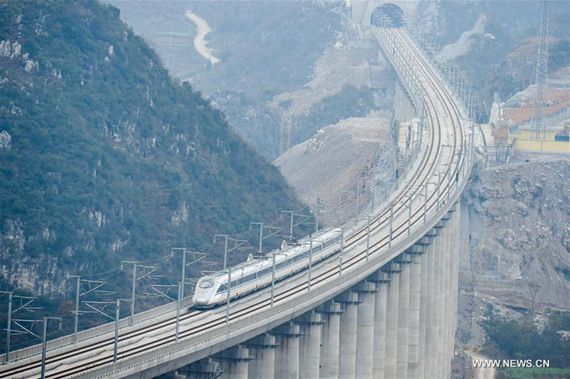
A test train in seen on the Guizhou West section of the Shanghai-Kunming high-speed railway, Dec. 17, 2016. (Xinhua/Ou Dongqu)
China on Wednesday put one of the world's longest high-speed railways into operation, linking the country's prosperous eastern coast with the less-developed southwest.
The Shanghai-Kunming line -- 2,252 km in length -- traverses five provinces, Zhejiang, Jiangxi, Hunan, Guizhou and Yunnan, and cuts the travel time from Shanghai to Kunming, capital city of Yunnan Province, from 34 to 11 hours, according to China Railway Corporation.
The maximum speed is 330 km per hour, said Wang Jingda, a train driver.
"Look son, the train is travelling at 160, 200, 300 km per hour. It is so fast," said a father on the train.
A girl at Kunming railway station told Xinhua she is excited because she can now join her husband every day, with a short 40 minute ride. The two live in different cities 235 km apart.
The Shanghai-Kunming line is the longest east to west high-speed railway in China. The north to south 2,298-km Beijing-Guangzhou line is even longer and started in 2012.
China has built more than 20,000 km of high-speed rail lines. The mileage will increase to 45,000 km by 2030. The launch of the Shanghai-Kunming line means the country's high-speed rail grid has taken shape, connecting almost all provincial-level regions on the Chinese mainland.
On Wednesday another high-speed rail line, linking Kunming and Nanning, capital of southwest China's Guangxi Zhuang Autonomous Region, was launched.
Yunnan is home to 25 indigenous ethnic minorities. Attendants on the Shanghai-Kunming line are trained to be multilingual. One of the attendants Yang Yanzhu, for example, speaks eight local languages.
TOURISM DRIVE
The Shanghai-Kunming line has been touted by some as the most beautiful high-speed railway route in China as many of the train stops are tourist sites. Yunnan, itself, is a big draw for Chinese tourists as the region boasts snow-capped mountains, canyons, tropical forests, and ethnic villages.
Trains have contributed to a tourist boom in several southwest cities in the past few years.
Last year, about 75 percent of visitors to Guilin, a tourist city in Guangxi region, arrived by train, said Vice Mayor Zhang Xiaowu. The inland city has been linked to Guangzhou, the provincial capital of Guangdong, since 2013.
Huang Zhihao, an official in Guangzhou's neighboring city of Foshan, said local travelers to Guizhou increased seven-fold, while those to Guangxi rose 67 percent in 2015.
After the launch of the Shanghai-Kunming line, the annual growth of Kunming's tourist arrivals is expected to double, according to Kunming Municipal Tourism Development Commission.
"Yunnan tourism will get a boost. People can reach their destinations faster and spend more time relaxing," said Ming Qingzhong with Yunnan University of Finance and Economics.
ECONOMIC DEVELOPMENT
Besides tourism, the rail line connects Yunnan with one of the country's most vibrant economic powerhouses -- the Shanghai-centered Yangtze River Delta economic zone.
The size of the Yunnan economy was about half that of Shanghai in 2015. Local governments and business people expect the connection may help the land-locked provinces of Yunnan and Guizhou to develop.
Yunnan's border trade with Thailand, Myanmar and Vietnam is also expected to get a lift.
"It will be faster for us to travel on high-speed trains," said Chandara, a Laotian businessman. "I am so excited."
The developed regions have advantages in capital, technology and talent, while Guangxi and Guizhou are rich in resources.
With rail lines improving connectivity, the southwest cities eye increasing investment and migration for jobs.
In Guizhou's city of Duyun, over 100 furniture factories from Guangzhou opened stores there after the train service was launched three years ago.
And the government has since ramped up training to help young locals to seek jobs in the Pearl River Delta, the country's manufacturing hub.


















































